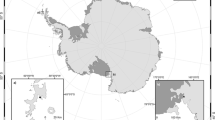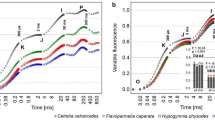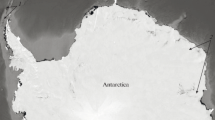Abstract
Lichens make up a major component of Antarctic vegetation; they are also poikilohydric and are metabolically active only when hydrated. Logistic constraints have meant that we have little idea of the length, timing or environmental conditions of activity periods of lichens. We present the results of a three-year monitoring of the activity of the lichen Umbilicaria aprina at Botany Bay (77°S latitude) in the Ross Sea region, continental Antarctica. Chlorophyll fluorescence parameters that allowed hydrated metabolic activity to be detected were recorded with a special fluorometer at 2- or 3-h intervals. Air and thallus temperatures and incident PPFD (photosynthetic photon flux density, μmol photon m−2 s−1) were also recorded at hourly intervals. Activity was extremely variable between months and years and, overall, lichen was active for 7% of the 28-month period. Spring snow cover often delayed the onset of activity. Whereas the period immediately after snow melt was often very productive, the later months, January to March, often showed low or no activity. Mean thallus temperature when active was just above zero degrees and much higher than the annual mean air temperature of −15 to −19°C. Because major snow melts occurred when incident radiation was high, the lichen was also subjected to very high PPFD when active, often more than 2,500 μmol photon m−2 s−1. The major environmental stress appeared to be high light rather than low temperatures, and the variability of early season snow fall means that prediction of activity will be very difficult.








Similar content being viewed by others
References
Clarke LJ, Robinson SA (2008) Cell wall-bound UV-screening pigments explain the high ultraviolet tolerance of the Antarctic moss, Ceratodon purpureus. New Phytol 179:776–783
Darbishire OV (1910) Lichenes. In: National Antarctic Expedition, 1901–1904. Natural History, vol V, Zoology and Botany. British Museum, London, p 1
Gauslaa Y, Solhaug KA (2001) Fungal melanins as a sun screen for symbiotic green algae in the lichen Lobaria pulmonaria. Oecologia 126:462–471
Green TGA (2009) Lichens in arctic, antarctic and alpine ecosystems. Rundgespräche Kommission Ökologie Ökologische Rolle Flechten 36:45–65
Green TGA, Schlensog M, Sancho LG, Winkler B, Broom FD, Schroeter B (2002) The photobiont determines the pattern of photosynthetic activity within a single lichen thallus containing cyanobacterial and green algal sectors (photosymbiodeme). Oecologia 130:191–198
Green TGA, Kulle D, Pannewitz S, Sancho LG, Schroeter B (2005) UV-A protection in mosses growing in continental Antarctica. Polar Biol 28:822–827
Green TGA, Schroeter B, Sancho LG (2007) Plant life in Antarctica. In: Pugnaire FI, Valladares F (eds) Functional plant ecology, 2nd edn. Marcel Dekker Inc., New York, pp 389–433
Hovenden MJ, Jackson AE, Seppelt RD (1994) Field photosynthetic activity of lichens in the Windmill Islands oasis, Wilkes Land, continental Antarctica. Physiol Plant 90:567–576
Kappen L (1993) Lichens in the Antarctic region. In: Friedmann EI (ed) Antarctic microbiology. Wiley-Liss, New York, pp 433–490
Kappen L (2000) Some aspects of the great success of lichens in Antarctica. Antarct Sci 12:314–324
Kappen L, Redon J (1987) Photosynthesis and water relations of three maritime antarctic lichen species. Flora 179:215–229
Kappen L, Schroeter B (1997) Activity of lichens under the influence of snow and ice. Proc NIPR Symp Polar Biol 10:163–168
Kappen L, Schroeter B (2002) Plants and lichens in the Antarctic, their way of life and their relevance to soil formation. In: Beyer L, Bölter M (eds) Geoecology of Antarctic ice-free coastal landscapes. ecological studies. Springer, Berlin, pp 327–373
Kappen L, Valladares F (2007) Opportunistic growth and desiccation tolerance, the ecological success of the poikilohydrous strategy. In: Pugnaire FI, Valladares F (eds) Functional plant ecology, 2nd edn. Marcel Dekker Inc., New York, pp 121–194
Kappen L, Schroeter B, Green TGA, Seppelt RD (1998) Chlorophyll a fluorescence and CO2 exchange of Umbilicaria aprina under extreme light stress in the cold. Oecologia 113:325–331
Kennedy AD (1993) Water as a limiting factor in the Antarctic terrestrial environment: a biogeographical synthesis. Arct Alp Res 25:308–315
Körner C (1999) Alpine plant life. Springer, Berlin
Körner C (2003) Plant life—functional plant ecology of high mountain ecosystems. Springer, Berlin
Lange OL (2003a) Photosynthetic productivity of the epilithic lichen Lecanora muralis: long-term field monitoring of CO2 exchange and its physiological interpretation. II. Diel and seasonal patterns of net photosynthesis and respiration. Flora 198:55–70
Lange OL (2003b) Photosynthetic productivity of the epilithic lichen Lecanora muralis: long-term field monitoring of CO2 exchange and its physiological interpretation. III. Diel, seasonal, and annual carbon budgets. Flora 198:277–292
Leisner JMR, Green TGA, Lange OL (1997) Photobiont activity of a temperate crustose lichen: long-term chlorophyll fluorescence and CO2 exchange measurements in the field. Symbiosis 23:165–182
Lud D, Schlensog M, Schroeter B, Huiskes AHL (2003) The influence of UV-B radiation on light dependent photosynthetic performance in Sanionia uncinata (Hedw.) Loeske in Antarctica. Polar Biol 26:225–232
Pannewitz S, Schlensog M, Green TGA, Sancho LG, Schroeter B (2003) Are lichens active under snow in continental Antarctica? Oecologia 135:30–38
Pannewitz S, Green TGA, Maysek K, Schlensog M, Seppelt RD, Sancho LG, Türk R, Schroeter B (2005) Photosynthetic responses of three common mosses from continental Antarctica. Antarct Sci 17:341–352
Pannewitz S, Green TGA, Schlensog M, Seppelt RD, Sancho LG, Schroeter B (2006) Photosynthetic performance of Xanthoria mawsonii Dodge in coastal habitats, Ross Sea region, continental Antarctica. Lichenologist 38:67–81
Pintado A, Sancho LG, Blanquer JM, Green TGA, Lázaro R. (2010) Microclimatic factors and photosynthetic activity of crustose lichens from the semiarid southeast of Spain: long-term measurements for Diploschistes diacapsis. Bibl Lichenol 106 (in press)
Sancho LG, Pintado A, Valladares F, Schroeter B, Schlensog M (1997) Photosynthetic performance of cosmopolitan lichens in the maritime Antarctic. Bibl Lichenol 67:197–210
Sancho LG, Pintado A, Green TGA, Pannewitz S, Schroeter B (2003) Photosynthetic and morphological variation within and among populations of the antarctic lichen Umbilicaria aprina: implications of thallus size. Bibl Lichenol 86:299–311
Sancho LG, Green TGA, Pintado A (2007) Slowest to fastest: extreme range in lichen growth rates supports their use as an indicator of climate change in Antarctica. Flora 202:667–673
Schlensog M, Schroeter B (2000) Poikilohydry in antarctic cryptogams and its role for photosynthetic performance in mesic and xeric habitats. In: Davidson W, Howard-Williams C, Broady P (eds) Antarctic ecosystems: models for wider ecological understanding. Christchurch, The Caxton Press, pp 175–182
Schlensog M, Schroeter B (2001) A new method for the accurate in situ monitoring of chlorophyll a fluorescence in lichens and bryophytes. Lichenologist 33:443–452
Schlensog M, Pannewitz S, Green TGA, Schroeter B (2004a) Metabolic recovery of continental antarctic cryptogams after winter. Polar Biol 27:399–408
Schlensog M, Schroeter B, Pannewitz S, Green TGA (2004b) Adaptation of mosses and lichens to irradiance stress in maritime and continental antarctic habitats. In: Huiskes AHL, Gieskes WWC, Rozema J, Schorno RML, van der Vies SM, Wolff WJ (eds) Antarctic biology in a global context. Backhuys Publ, Leiden, pp 161–166
Schreiber U, Bilger W, Neubauer C (1994) Chlorophyll fluorescence as a nonintrusive indicator for rapid assessment of in vivo photosynthesis. In: Schulze ED, Caldwell MM (eds) Ecophysiology of photosynthesis. Ecological studies, vol 100. Springer, Berlin, pp 49–70
Schroeter B (1994) In situ photosynthetic differentiation of the green algal and the cyanobacterial photobiont in the crustose lichen Placopsis contortuplica. Oecologia 98:212–220
Schroeter B (1997) Grundlagen der Stoffproduktion von Kryptogamen unter besonderer Berücksichtigung der Flechten. Eine Synopse, Habilitationsschrift. Christian-Albrechts-Universität zu Kiel, Kiel
Schroeter B, Scheidegger C (1995) Water relations in lichens at subzero temperatures: structural changes and carbon dioxide exchange in the lichen Umbilicaria aprina from continental Antarctica. New Phytol 131:273–285
Schroeter B, Kappen L, Moldaenke C (1991) Continuous in situ recording of the photosynthetic activity of Antarctic lichens—established methods and a new approach. Lichenologist 23:253–265
Schroeter B, Green TGA, Seppelt RD, Kappen L (1992) Monitoring photosynthetic activity of crustose lichens using a PAM-2000 fluorescence system. Oecologia 92:457–462
Schroeter B, Green TGA, Kappen L, Seppelt RD (1994) Carbon dioxide exchange at subzero temperatures. Field measurements on Umbilicaria aprina in Antarctica. Crypt Bot 4:233–241
Schroeter B, Olech M, Kappen L, Heitland W (1995) Ecophysiological investigations of Usnea antarctica in the maritime Antarctic. I. Annual microclimatic conditions and potential primary production. Antarct Sci 7:251–260
Schroeter B, Kappen L, Green TGA, Seppelt RD (1997) Lichens and the Antarctic environment: effects of temperature and water availability on photosynthesis. In: Lyons B, Howard-Williams C, Hawes I (eds) Ecosystem processes in Antarctic ice-free landscapes. Balkema, Rotterdam, pp 103–117
Schroeter B, Kappen L, Schulz F, Sancho L (2000) Seasonal variation in the carbon balance of lichen in the maritime Antarctic: Long-term measurements of photosynthetic activity in Usnea aurantiaco-atra. In: Davidson W, Howard-Williams C, Broady P (eds) Antarctic ecosystems: models for wider ecological understanding. The Caxton Press, Christchurch, pp 258–262
Seppelt RD, Green TGA (1998) A bryophyte flora for Southern Victoria Land, Antarctica. NZ J Bot 36:617–635
Seppelt RD, Green TGA, Schroeter B (1995) Lichens and mosses from the Kar Plateau, southern Victoria Land, Antarctica. NZ J Bot 34:203–220
Søchting U, Seppelt RD (2003) Caloplaca coeruleofrigida sp. nova, a lichen from continental Antarctica. Mycotaxon 86:163–168
Acknowledgments
B.S., S.P. and M.S. gratefully acknowledge financial support by Deutsche Forschungs-Gemeinschaft (DFG SCHR 473/4-3) and by Spanish MCI (CTM2009-12838-C01). TGAG thanks Professor Bryan Gould, Vice-Chancellor of Waikato University for continual funding of the Antarctic research programme. Antarctica New Zealand is thanked for providing logistics both for the research in Antarctica and movements to Antarctica and their staff for assisting with reading and removal of the monitoring equipment. TGAG was supported by Ramon y Cajal Fellowship at Vegetal II, Farmacia, Universidad Complutense, Madrid, Spain, and by FRST grant—Understanding, valuing and protecting Antarctica’s unique terrestrial ecosystems: Predicting biocomplexity in Dry Valley ecosystems, during the writing of this paper. A special thanks goes to Prof. Ute Harms, IPN, Kiel, Germany, for support to BS.
Author information
Authors and Affiliations
Corresponding author
Additional information
Dedicated to Prof. Dr. Roman Türk on the occasion of his 65th birthday.
Rights and permissions
About this article
Cite this article
Schroeter, B., Green, T.G.A., Pannewitz, S. et al. Summer variability, winter dormancy: lichen activity over 3 years at Botany Bay, 77°S latitude, continental Antarctica. Polar Biol 34, 13–22 (2011). https://doi.org/10.1007/s00300-010-0851-7
Received:
Revised:
Accepted:
Published:
Issue Date:
DOI: https://doi.org/10.1007/s00300-010-0851-7




